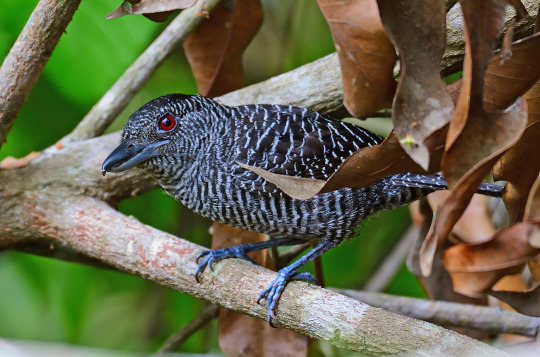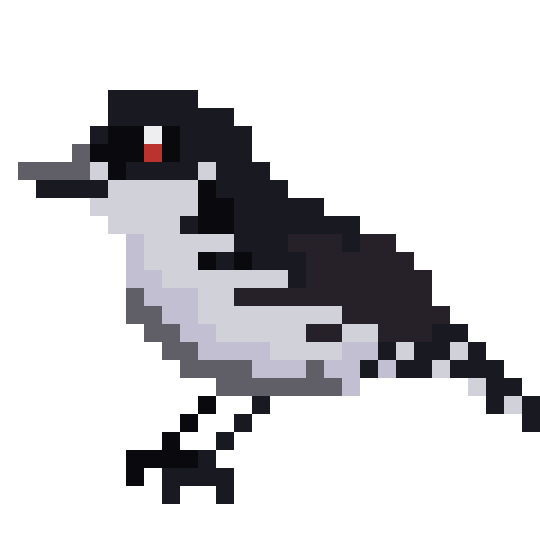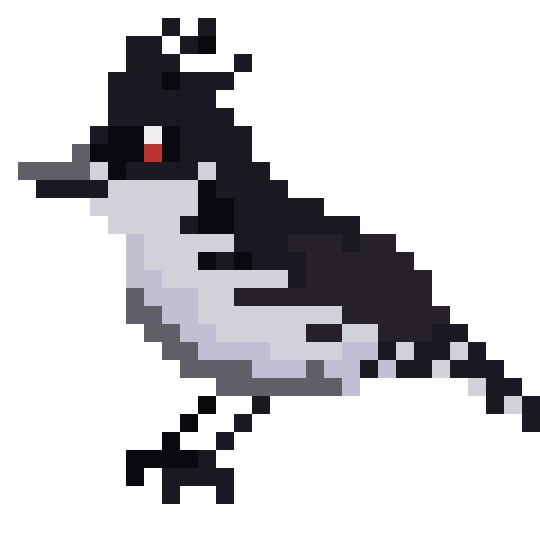#antshrike
Explore tagged Tumblr posts
Text

Fasciated Antshrike (Cymbilaimus lineatus), family Thamnophilidae, order Passeriformes, Costa Rica
Antshrikes, antbirds, antwrens, and antpittas get their names from the practice of following columns of army ants. They prey on insects and other small animals which flee or escape the ants.
photograph by Jason Tiesman
265 notes
·
View notes
Text

September 20, 2023 - Black-hooded Antshrike (Thamnophilus bridgesi) Found along the Pacific slope of Costa Rica and western Panama, these antbirds live in a variety of forested habitats, including mangroves. Foraging alone or in pairs and often joining mixed-species flocks, they feed on insects and other arthropods, picking prey from surfaces in vine tangles or on the ground. They sometimes follow army ants, capturing prey as it flees the swarm. Breeding from February to September in Costa Rica, they build cup-shaped nests from rootlets and other fibers, spiderwebs, and green moss, attached to forked branches by the rim. Both parents incubate the clutches of two eggs and feed the chicks.
#black-hooded antshrike#antshrike#antbird#thamnophilus bridgesi#bird#birds#illustration#art#tropical#birblr art
51 notes
·
View notes
Photo

#508, a barred antshrike for @iamtheonethinginlifeicancontrol. This one was quite the challenge. Requests for birds are open, updates happen on Thursdays. [project tag] | [kofi] [commissions] Find me on: [twitter]
74 notes
·
View notes
Text







New bird species so far in 2024 (some already added to the AVE):
Researchers propose a split of The Silvery-Cheeked Antshrike into Northern and Southern Species based on vocal and morphological distinctions.
The Timor Nightjar is a new species from the islands of Timor and Wetar in the Lesser Sunda Islands,
The Giant Hummingbird has been split into a non-migrating Northern species and a migratory Southern species
Researchers propose splitting populations of the Black-Goggled Tanager into an Atlantic forest species and an Andean species
An undescribed new Antpitta from Colombia goes by names like Antioquia Antpitta, Paisita (referencing the local people) and Santa Rosa Antpitta. I think Antioquia Antpitta has already been suggested as a name for the Urroa Antpitta. Anyone know about that?
#silvery cheeked antshrike#timor nightjar#giant hummingbird#black goggled tanager#paisita#new bird species#AVE#Avian Vector Encyclopedia
178 notes
·
View notes
Text
Sakesphoroides niedeguidonae Cerqueira et al., 2024 (new species)

(Illustration of male [back] and female [front] individuals of Sakesphoroides niedeguidonae by Eduardo Brettas, from Cerqueira et al., 2024)
Meaning of name: niedeguidonae = for Niède Guidon [Brazilian archaeologist]
Suggested common name: Northern silvery-cheeked antshrike
Age: Holocene (Meghalayan), extant
Where found: Dry forest and scrub in northeastern Brazil, mostly on the northern/western bank of the São Francisco River
How much is known: At least 83 collected specimens are held in museum collections.
Notes: S. niedeguidonae is an antbird, a diverse group of small birds from the American tropics. Antbirds are so named because some species follow army ants to feed on small animals fleeing from the ant swarms, though this behavior has not been observed in the genus Sakesphoroides.
Sakesphoroides is found solely in the dry forest and shrubland (Caatinga) of northeastern Brazil. Only one species in this genus had previously been recognized, S. cristatus. However, a new study argues that the northern and southern populations of Sakesphoroides should be classified as distinct species based on genetic, vocal, and anatomical differences. The southern populations keep the name S. cristatus and are given the suggested common name of southern silvery-cheeked antshrike, whereas the northern populations are described as a new species, S. niedeguidonae.
Males of the two species are difficult to tell apart. Among females, however, S. niedeguidonae differs from S. cristatus in having more strongly barred tail feathers, a lighter brown crest on the head, and an olive brown (instead of cinnamon brown) back.
Seasonally dry tropical forests such as the Caatinga have traditionally been thought of as having low biodiversity and few unique species compared to tropical rainforests, but recent discoveries such as S. niedeguidonae have shown that much of dry forest biodiversity has likely been historically overlooked.
Reference: Cerqueira, P., G.R. Gonçalves, T.F. Quaresma, M. Silva, M. Pichorim, and A. Aleixo. 2024. A new antshrike (Aves: Thamnophilidae) endemic to the Caatinga and the role of climate oscillations and drainage shift in shaping cryptic diversity of Neotropical seasonal dry forests. Zoologica Scripta advance online publication. doi: 10.1111/zsc.12672
#Birblr#Dinosaurs#Birds#Sakesphoroides niedeguidonae#Northern silvery-cheeked antshrike#Holocene#South America#Telluraves#2024#Extant
79 notes
·
View notes
Text
BOTD: Fasciated Antshrike

Photo: Ad Konings
"Antshrikes have proportionally large, flat heads and large, hooked bills, and they often cock their tails down. Fasciated Antshrike is widespread through Central and South America. Most often seen in pairs, and often moves higher than other antshrike species, at middle levels or even the canopy of thick edges and tangles. Can be difficult to get a clear view. Listen for series of mournful rising whistled notes."
- eBird
#birds#fasciated antshrike#birds of north america#north american birds#antshrikes#antbirds#passerines#birds of central america#birding#birdblr#birblr#bird watching#bird of the day#Cymbilaimus lineatus
59 notes
·
View notes
Photo

A new variant has been added!
Band-tailed Antshrike (Thamnophilus melanothorax) © hbottai
It hatches from black, broad, colored, dense, difficult, distinctive, fond, harsh, hollow, large, much, other, rusty, slow, and white eggs.
squawkoverflow - the ultimate bird collecting game 🥚 hatch ❤️ collect 🤝 connect
2 notes
·
View notes
Text




Today’s pixel art bird is the great antshrike! I don’t have a photo of this bird species, as I have never had the privilege of seeing it in person. This shrike resembling antbird is sexually dimorphic in color, but both makes and females have a crest.
#Taraba major#great antshrike#pixel art#image description in alt#bird art#birds#I am sleepy so I will add the fun facts later
3 notes
·
View notes
Note

THAS ME
5 notes
·
View notes
Video
#sileneandrade#Barred Antshrike#Thamnophilidae#Thamnophilus doliatus#Arte Digital#Choca-barrada#Área de Proteção Ambiental#Deck do Lago Sul#Nikon#Pássaro#Pássaro Silvestre#Wild Bird#Bird Watcher#In Nature#FREE BIRD#Forest#Green#Flickr for the Planet#flickr
1 note
·
View note
Text

variable antshrike (Thamnophilus caerulescens) by Jacques Passamani
0 notes
Text

Giant Antshrike (Batara cinerea), family Thamnophilidae, order Passeriformes, Eldorado, São Paulo, Brazil
Antshrikes, antbirds, antwrens, and antpittas get their names from the practice of following columns of army ants. They prey on insects and other small animals which flee or escape the ants.
photograph by Yung Niem (@niemyungphotography)
531 notes
·
View notes
Text

May 29, 2023 - Black-crowned Antshrike or Western Slaty Antshrike (Thamnophilus atrinucha) Found in parts of Colombia, Costa Rica, Ecuador, Honduras, Belize, Guatemala, Nicaragua, Panama, and Venezuela, these antshrikes live in lowland and mountain forests. They eat mostly insects and other invertebrates, along with some small lizards, foraging in dense tangles, sometimes with mixed-species flocks and rarely following army ant swarms. Pairs build open cup-shaped nests from threadlike fungal structures, moss, spiderwebs, and rootlets where females usually lay two eggs. Though the eggs are laid two days apart they hatch within several hours of each other. Males typically feed the larger chick while females feed the smaller one. Fledglings sometimes help collect nest material for their parents and help defend the territory.
#black-crowned antshrike#antshrike#thamnophilus atrinucha#bird#birds#illustration#art#tropical#birblr art
47 notes
·
View notes
Video
23-1 by Henry Via Flickr: Hummingbird
#Hummingbird#bird#birds#Canon#nature#Curved bill thrasher#Scarlet flycatcher#Thick bill kingbird#Black gray antshrike#Hummingbirds#flickr
0 notes
Text

DOUBLE THE ANTSHRIKES, DOUBLE THE FUN!!!
1K notes
·
View notes
Text
Inspired by me trying to study for a Costa Rica trip and there's just so many Antguys.
70 notes
·
View notes

